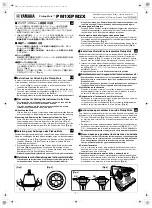
Non-sinusoidal waveforms may cause :
– Overheated transformers, generator and motors to burn out faster than normal
– Circuit breakers to trip prematurely
– Fuses to blow
– Neutrals to be overheated due to the triplen harmonics present on the neutral
– Bus bars and electrical panels to vibrate
Crest Factor
Crest Factor is the ratio of the Crest (instantaneous peak) value to the True RMS
value, which is commonly used to define the dynamic range of a True RMS DMM.
A pure sinusoidal waveform has a Crest Factor of 1.414.
A badly distorted sinusoidal waveform normally has a much higher Crest Factor.
NMRR (Normal Mode Rejection Ratio)
NMRR is the DMM’s ability to reject unwant ed AC noise effect which can cause
inaccurate DC measurements. NMRR is typically specified in terms of dB (decibel).
The Meter has a NMRR specification of > 60dB at 50Hz/60Hz, which means a good
ability to reject the effect of AC noise in DC measurements.
CMRR (Common Mode Rejection Ratio)
Common mode voltage is voltage existing on both the COM and V oltage i n p u t
t erminals of a DMM, with respect to ground. CMRR is a DMM’s ability to reject
common mode voltage effect which can cause digit rat tle or of fset in volt age
measurements. The Meter has a CMRR specification of > 60dB at DC to 60 Hz in
AC volts measurement function and > 120 dB at DC, 50Hz and 60Hz in DC volts
measurement function.
Burden Voltage
Burden voltage is a voltage drop across the input terminals of a current-measuring
device, caused by internal shunt resistance.
Burden voltage contributes measurement error, and should be as low as practical.
Temperature Coefficient
Temperature Coefficient is a factor used to calculate t he change in indication or
output of an instrument with changes in temperature.
Uncompensat ed changes in temperature contribute uncertainty by an amount
determined by the temperature coefficient to instrument.
Turning the Meter On
To turn the meter on, turn the rotary switch from OFF to any switch setting.
Rotary Switch
Turn the meter on by selecting any measurement function. The meter presents a
standard display for that func tion (range, meas urement units , etc. ). Use the
SELECT button to select any rotary switch alternate function.
When you turn the rotary switch from one function to another, a display for the new
function appears. But ton choices made in one function do not carry over int o
another function.
OFF. Turns the meter off.
. (Model 703). Volts ac rms and Volts dc.
. (Model 701). Volts ac.
. (Model 701). Volts dc.
. Access to resistance measurement, continuity test and diode test.
Hz (Duty). Frequency measurement. Duty cycle is also displayed if it is toggled by
the Hz / Duty button.
CAP. Capacitance measurement.
Temp (Model 703 onl y). Temperat ure measurement in degrees Centigrade or
Fahrenheit. Changing the reading mode should be preset at the factory.
. Micro-amps ac rms and micro-amps dc measurements (Model 703).
Micro-amps ac and micro-amps dc measurements (Model 701).
. Milli-amps ac rms and milli-amps dc measurements (Model 703).
Milli-amps ac and milli-amps dc measurements (Model 701).
4. ROTARY SWITCH AND PUSHBUTTON OVERVIEW
7
6

































